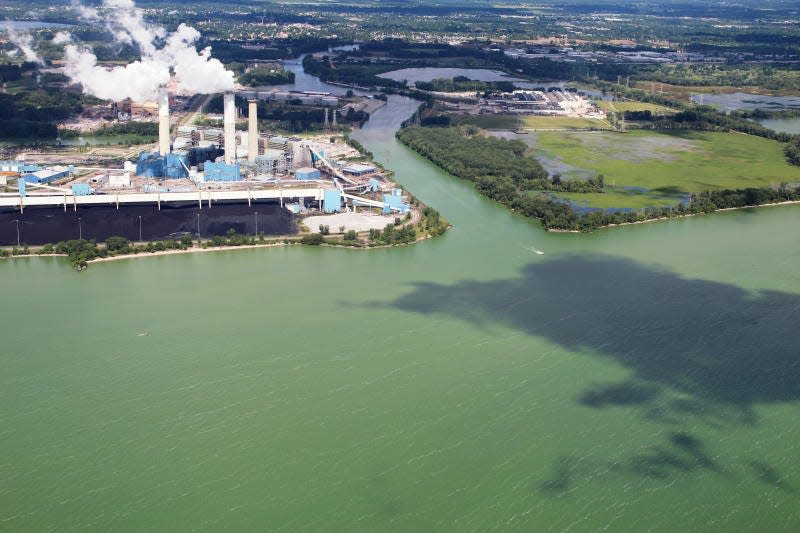Insanity loop on water quality improvement efforts has to stop

They’re back. The same slimy masses return to western Lake Erie, Saginaw Bay, Lake Michigan and many of our local inland lakes here every year. They can be pea-soup green like thick paint on the surface, cyan blue, red, brownish-green or just scum. They might look like lava-lamp swirls hanging just under water, invisible on the surface. They’re called HABs — harmful algae or blue-green algae blooms — but they’re not true plant algae. They’re cyanobacteria, one of the planet’s oldest life forms. Like plants, they get their energy through photosynthesis. Cyanobacteria use the nutrients phosphorus and nitrogen, but their limiting nutrient is phosphorus. Cyanobacteria “feed” mostly on the compound orthophosphate, with phosphorus in soluble or dissolved form. Dissolved phosphorus will pass through pharmaceutical-grade (0.45 micron) filtration.
Some cyanobacteria can produce dangerous algal toxins (cyanotoxins). In our region, which is the Western Lake Erie Basin and its headwater tributaries here of the Raisin River and Bean Creek (Tiffin River in Ohio), the most common cyanobacteria are Microcystis, Anabaena (Dolichospermum), Planktothrix, and Cylindrospermopsis. Each can produce one or more of these toxins: microcystin, anatoxin, cylindrospermopsin. Most samples I’ve collected are combinations of these.
During Toledo’s 2014 water crisis, residents of the entire metropolitan area lost their tap water because microcystin was found in the city’s treated drinking water at the treatment plant. Cyanobacteria can cause diarrhea and skin rashes. Cyanotoxins, which are odorless, colorless and only visible through high-powered magnification, can cause systemic damage and can be fatal. Boiling water concentrates cyanotoxins. You can’t filter released cyanotoxins out with typical pitcher, faucet or most home water systems, even those that are NSF certified for removing bacteria and lead.

Many states (like Ohio) have water quality standards and reporting requirements for cyanobacteria and cyanotoxins in their surface and treated drinking water, but Michigan doesn’t. The U.S. EPA listed cyanotoxins and cyanobacteria on its contaminant candidate list for regulation in 1998, but still only makes recommendations. So regulation is up to states, and Michigan has chosen to follow those lesser recommendations instead of safer protections like Ohio’s. However, municipal water treatment utilities can individually address this growing problem.
That’s exactly what Ann Arbor, which has a blended surface and groundwater system like Adrian’s, and Monroe did. So did Toledo. Traditionally, utilities treat for cyanobacteria and cyanotoxins with mechanical filtration, activated carbon, potassium permanganate, and chlorine or chloramines. Those cities took the critical step of adding ozone treatment. Taxpayers spent millions of dollars on these upgrades.
Agriculture is western Lake Erie’s major phosphorus contributor, even more so here in Lenawee County. Hundreds of millions of dollars have been spent in this region on endless studies and programs like Michigan Agriculture Environmental Assurance Program in Michigan and now H2Ohio, suites of agricultural best management practices originally developed to build soil health, that have been promoted as nutrient pollution controls. But years of data and regional field studies show these aren’t keeping enough phosphorus from agriculture out of our region’s massive subsurface tile network or surface water. The December 2021 version of Michigan’s Adaptive Management Plan to Reduce Phosphorus Loading into Lake Erie by 40% by 2025 reported that, despite decades of this approach, dissolved (soluble) phosphorus and total phosphorus loads stayed the same or are increasing in the Raisin.
The same thing’s happening in the Maumee.
Then there’s the enormous economic loss to the tourism industry and to property values.
Over-reliance on these practices to the exclusion of better, more source-targeted measures has led us to this: We won’t reach that 40% phosphorus reduction goal by 2025. At the very least, we need benchmarks that include numeric targets with measurable improvement requirements based on water quality testing instead of acres-enrolled modeling, with timelines and enforceable consequences. The time for wasting more taxpayer money on misdirected research, ineffective voluntary programs and transferring pollution costs to others downstream has long passed.
Pam Taylor is a retired Lenawee County teacher and an environmental activist. She can be reached at ptaylor001@msn.com.
This article originally appeared on The Daily Telegram: Pam Taylor: Insanity loop on water quality improvement has to stop

